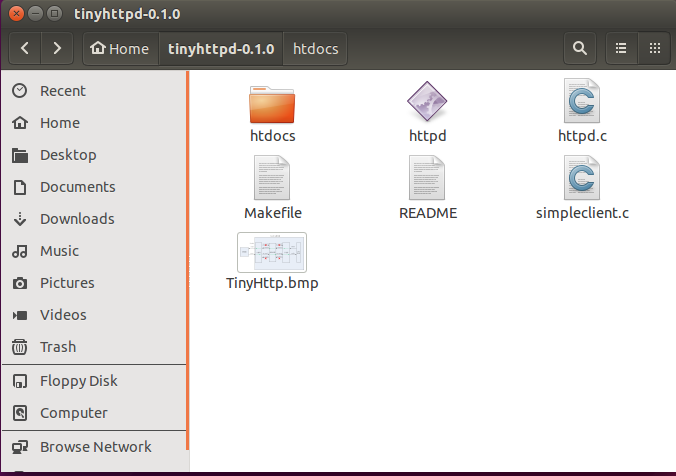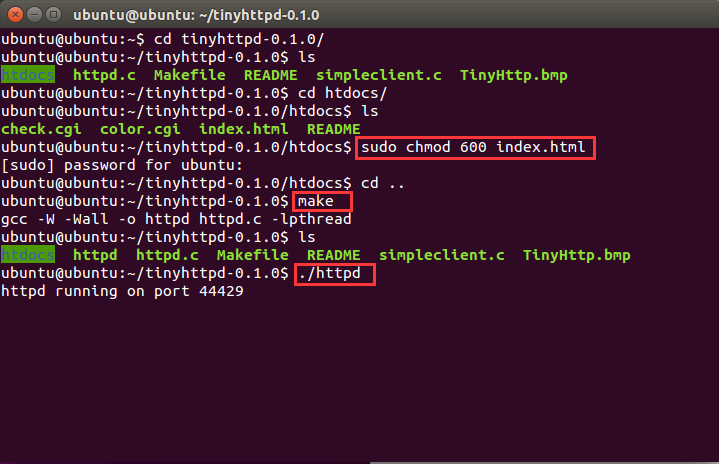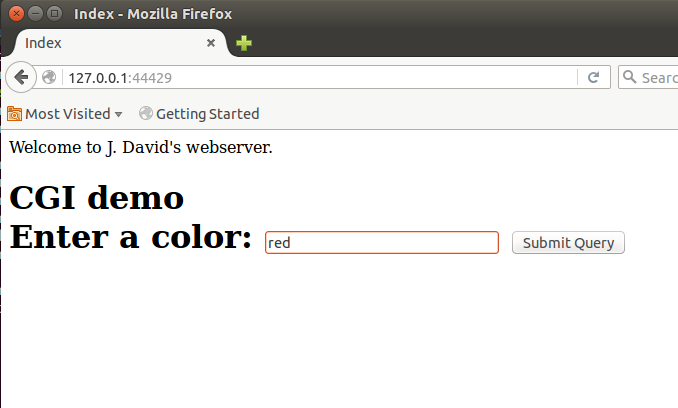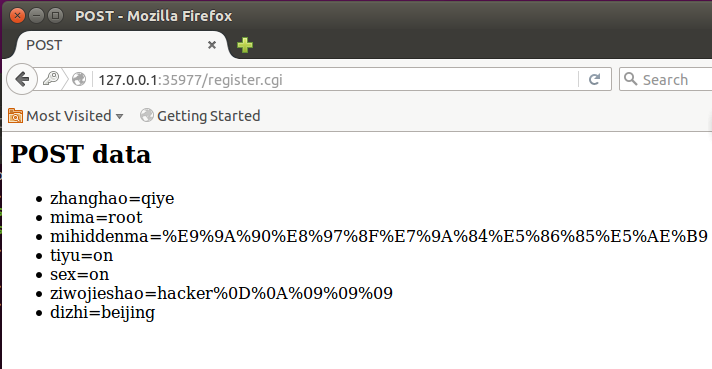已经有一个月没有更新博客了,一方面是因为平时太忙了,另一方面是想积攒一些干货进行分享。最近主要是做了一些开源项目的源码分析工作,有c项目也有python项目,想提升一下内功,今天分享一下tinyhttpd源码分析的成果。tinyhttpd是一个非常轻量型的http服务器,c代码500行左右,可以帮助我们了解http服务器运行的实质。在分析之前,我们先说一下http报文。(我的新书《Python爬虫开发与项目实战》出版了,大家可以看一下样章)
一.http请求
http请求由三部分组成,分别是:起始行、消息报头、请求正文
Request Line<CRLF>
Header-Name: header-value<CRLF>
Header-Name: header-value<CRLF>
//一个或多个,均以<CRLF>结尾
<CRLF>
body//请求正文
1、起始行以一个方法符号开头,以空格分开,后面跟着请求的URI和协议的版本,格式如下:
Method Request-URI HTTP-Version CRLF其中 Method表示请求方法;Request-URI是一个统一资源标识符;HTTP-Version表示请求的HTTP协议版本;CRLF表示回车和换行(除了作为结尾的CRLF外,不允许出现单独的CR或LF字符)。
2、请求方法(所有方法全为大写)有多种,各个方法的解释如下:
- GET 请求获取Request-URI所标识的资源
- POST 在Request-URI所标识的资源后附加新的数据
- HEAD 请求获取由Request-URI所标识的资源的响应消息报头
- PUT 请求服务器存储一个资源,并用Request-URI作为其标识
- DELETE 请求服务器删除Request-URI所标识的资源
- TRACE 请求服务器回送收到的请求信息,主要用于测试或诊断
- CONNECT 保留将来使用
- OPTIONS 请求查询服务器的性能,或者查询与资源相关的选项和需求
应用举例:
GET方法:在浏览器的地址栏中输入网址的方式访问网页时,浏览器采用GET方法向服务器获取资源,eg:
GET /form.html HTTP/1.1 (CRLF)POST方法要求被请求服务器接受附在请求后面的数据,常用于提交表单。eg:
POST /reg.jsp HTTP/ (CRLF)
Accept:image/gif,image/x-xbit,... (CRLF)
...
HOST:www.guet.edu.cn (CRLF)
Content-Length:22 (CRLF)
Connection:Keep-Alive (CRLF)
Cache-Control:no-cache (CRLF)
(CRLF) //该CRLF表示消息报头已经结束,在此之前为消息报头
user=jeffrey&pwd=1234 //此行以下为提交的数据
二.tinyhttpd源码分析
tinyhttpd总共包含以下函数:
void accept_request(int);//处理从套接字上监听到的一个 HTTP 请求
void bad_request(int);//返回给客户端这是个错误请求,400响应码
void cat(int, FILE *);//读取服务器上某个文件写到 socket 套接字
void cannot_execute(int);//处理发生在执行 cgi 程序时出现的错误
void error_die(const char *);//把错误信息写到 perror
void execute_cgi(int, const char *, const char *, const char *);//运行cgi脚本,这个非常重要,涉及动态解析
int get_line(int, char *, int);//读取一行HTTP报文
void headers(int, const char *);//返回HTTP响应头
void not_found(int);//返回找不到请求文件
void serve_file(int, const char *);//调用 cat 把服务器文件内容返回给浏览器。
int startup(u_short *);//开启http服务,包括绑定端口,监听,开启线程处理链接
void unimplemented(int);//返回给浏览器表明收到的 HTTP 请求所用的 method 不被支持。
建议源码阅读顺序: main -> startup -> accept_request -> execute_cgi
按照以上顺序,看一下浏览器和tinyhttpd交互的整个流程:

三.注释版源码
注释版源码已经放到github上了,以后所有的源码分析都会上传github上。由于tinyhttpd源码较少,下面将完整的代码贴出来。
/* J. David's webserver */
/* This is a simple webserver.* Created November 1999 by J. David Blackstone.* CSE 4344 (Network concepts), Prof. Zeigler* University of Texas at Arlington*/
/* This program compiles for Sparc Solaris 2.6.* To compile for Linux:* 1) Comment out the #include <pthread.h> line.* 2) Comment out the line that defines the variable newthread.* 3) Comment out the two lines that run pthread_create().* 4) Uncomment the line that runs accept_request().* 5) Remove -lsocket from the Makefile.*/
#include <stdio.h>
#include <sys/socket.h>
#include <sys/types.h>
#include <netinet/in.h>
#include <arpa/inet.h>
#include <unistd.h>
#include <ctype.h>
#include <strings.h>
#include <string.h>
#include <sys/stat.h>
#include <pthread.h>
#include <sys/wait.h>
#include <stdlib.h>#define ISspace(x) isspace((int)(x))
//函数说明:检查参数c是否为空格字符,
//也就是判断是否为空格(' ')、定位字符(' \t ')、CR(' \r ')、换行(' \n ')、垂直定位字符(' \v ')或翻页(' \f ')的情况。
//返回值:若参数c 为空白字符,则返回非 0,否则返回 0。#define SERVER_STRING "Server: jdbhttpd/0.1.0\r\n"//定义server名称void accept_request(int);//接收请求void bad_request(int);//无效请求
void cat(int, FILE *);
void cannot_execute(int);
void error_die(const char *);
void execute_cgi(int, const char *, const char *, const char *);
int get_line(int, char *, int);
void headers(int, const char *);
void not_found(int);
void serve_file(int, const char *);
int startup(u_short *);
void unimplemented(int);/**********************************************************************/
/* A request has caused a call to accept() on the server port to* return. Process the request appropriately.* Parameters: the socket connected to the client */
/**********************************************************************/
//接收客户端的连接,并读取请求数据
void accept_request(int client)
{char buf[1024];int numchars;char method[255];char url[255];char path[512];size_t i, j;struct stat st;int cgi = 0; /* becomes true if server decides this is a CGI* program */char *query_string = NULL;
//获取一行HTTP报文数据numchars = get_line(client, buf, sizeof(buf));//i = 0; j = 0;//对于HTTP报文来说,第一行的内容即为报文的起始行,格式为<method> <request-URL> <version>,//每个字段用空白字符相连while (!ISspace(buf[j]) && (i < sizeof(method) - 1)){//提取其中的请求方式是GET还是POSTmethod[i] = buf[j];i++; j++;}method[i] = '\0';
//函数说明:strcasecmp()用来比较参数s1 和s2 字符串,比较时会自动忽略大小写的差异。
//返回值:若参数s1 和s2 字符串相同则返回0。s1 长度大于s2 长度则返回大于0 的值,s1 长度若小于s2 长度则返回小于0 的值。if (strcasecmp(method, "GET") && strcasecmp(method, "POST")){//tinyhttp仅仅实现了GET和POSTunimplemented(client);return;}
//cgi为标志位,置1说明开启cgi解析if (strcasecmp(method, "POST") == 0)
//如果请求方法为POST,需要cgi解析cgi = 1;i = 0;//将method后面的后边的空白字符略过while (ISspace(buf[j]) && (j < sizeof(buf)))j++;//继续读取request-URLwhile (!ISspace(buf[j]) && (i < sizeof(url) - 1) && (j < sizeof(buf))){url[i] = buf[j];i++; j++;}url[i] = '\0';
//如果是GET请求,url可能会带有?,有查询参数if (strcasecmp(method, "GET") == 0){query_string = url;while ((*query_string != '?') && (*query_string != '\0'))query_string++;if (*query_string == '?'){//如果带有查询参数,需要执行cgi,解析参数,设置标志位为1cgi = 1;//将解析参数截取下来*query_string = '\0';query_string++;}}
//以上已经将起始行解析完毕
//url中的路径格式化到pathsprintf(path, "htdocs%s", url);
//学习到这里明天继续TODO
//如果path只是一个目录,默认设置为首页index.htmlif (path[strlen(path) - 1] == '/')strcat(path, "index.html");//函数定义: int stat(const char *file_name, struct stat *buf); //函数说明: 通过文件名filename获取文件信息,并保存在buf所指的结构体stat中 //返回值: 执行成功则返回0,失败返回-1,错误代码存于errno(需要include <errno.h>)if (stat(path, &st) == -1) {//假如访问的网页不存在,则不断的读取剩下的请求头信息,并丢弃即可while ((numchars > 0) && strcmp("\n", buf)) /* read & discard headers */numchars = get_line(client, buf, sizeof(buf));//最后声明网页不存在not_found(client);}else{//如果访问的网页存在则进行处理if ((st.st_mode & S_IFMT) == S_IFDIR)//S_IFDIR代表目录//如果路径是个目录,那就将主页进行显示strcat(path, "/index.html");if ((st.st_mode & S_IXUSR) ||(st.st_mode & S_IXGRP) ||(st.st_mode & S_IXOTH) )//S_IXUSR:文件所有者具可执行权限//S_IXGRP:用户组具可执行权限//S_IXOTH:其他用户具可读取权限 cgi = 1;if (!cgi)//将静态文件返回serve_file(client, path);else//执行cgi动态解析execute_cgi(client, path, method, query_string);}close(client);//因为http是面向无连接的,所以要关闭
}/**********************************************************************/
/* Inform the client that a request it has made has a problem.* Parameters: client socket */
/**********************************************************************/
void bad_request(int client)
{char buf[1024];
//发送400sprintf(buf, "HTTP/1.0 400 BAD REQUEST\r\n");send(client, buf, sizeof(buf), 0);sprintf(buf, "Content-type: text/html\r\n");send(client, buf, sizeof(buf), 0);sprintf(buf, "\r\n");send(client, buf, sizeof(buf), 0);sprintf(buf, "<P>Your browser sent a bad request, ");send(client, buf, sizeof(buf), 0);sprintf(buf, "such as a POST without a Content-Length.\r\n");send(client, buf, sizeof(buf), 0);
}/**********************************************************************/
/* Put the entire contents of a file out on a socket. This function* is named after the UNIX "cat" command, because it might have been* easier just to do something like pipe, fork, and exec("cat").* Parameters: the client socket descriptor* FILE pointer for the file to cat */
/**********************************************************************/
void cat(int client, FILE *resource)
{
//发送文件的内容char buf[1024];
//读取文件到buf中fgets(buf, sizeof(buf), resource);while (!feof(resource))//判断文件是否读取到末尾{//读取并发送文件内容send(client, buf, strlen(buf), 0);fgets(buf, sizeof(buf), resource);}
}/**********************************************************************/
/* Inform the client that a CGI script could not be executed.* Parameter: the client socket descriptor. */
/**********************************************************************/
void cannot_execute(int client)
{char buf[1024];
//发送500sprintf(buf, "HTTP/1.0 500 Internal Server Error\r\n");send(client, buf, strlen(buf), 0);sprintf(buf, "Content-type: text/html\r\n");send(client, buf, strlen(buf), 0);sprintf(buf, "\r\n");send(client, buf, strlen(buf), 0);sprintf(buf, "<P>Error prohibited CGI execution.\r\n");send(client, buf, strlen(buf), 0);
}/**********************************************************************/
/* Print out an error message with perror() (for system errors; based* on value of errno, which indicates system call errors) and exit the* program indicating an error. */
/**********************************************************************/
void error_die(const char *sc)
{perror(sc);exit(1);
}/**********************************************************************/
/* Execute a CGI script. Will need to set environment variables as* appropriate.* Parameters: client socket descriptor* path to the CGI script */
/**********************************************************************/
//执行cgi动态解析
void execute_cgi(int client, const char *path,const char *method, const char *query_string)
{char buf[1024];int cgi_output[2];//声明的读写管道,切莫被名称给忽悠,会给出图进行说明int cgi_input[2];//pid_t pid;int status;int i;char c;int numchars = 1;int content_length = -1;buf[0] = 'A'; buf[1] = '\0';if (strcasecmp(method, "GET") == 0)//如果是GET请求//读取并且丢弃头信息while ((numchars > 0) && strcmp("\n", buf)) numchars = get_line(client, buf, sizeof(buf));else {//处理的请求为POSTnumchars = get_line(client, buf, sizeof(buf));while ((numchars > 0) && strcmp("\n", buf)){//循环读取头信息找到Content-Length字段的值buf[15] = '\0';//目的是为了截取Content-Length:if (strcasecmp(buf, "Content-Length:") == 0)//"Content-Length: 15"content_length = atoi(&(buf[16]));//获取Content-Length的值numchars = get_line(client, buf, sizeof(buf));}if (content_length == -1) {//错误请求bad_request(client);return;}}
//返回正确响应码200sprintf(buf, "HTTP/1.0 200 OK\r\n");send(client, buf, strlen(buf), 0);
//#include<unistd.h>
//int pipe(int filedes[2]);
//返回值:成功,返回0,否则返回-1。参数数组包含pipe使用的两个文件的描述符。fd[0]:读管道,fd[1]:写管道。
//必须在fork()中调用pipe(),否则子进程不会继承文件描述符。
//两个进程不共享祖先进程,就不能使用pipe。但是可以使用命名管道。
//pipe(cgi_output)执行成功后,cgi_output[0]:读通道 cgi_output[1]:写通道,这就是为什么说不要被名称所迷惑if (pipe(cgi_output) < 0) {cannot_execute(client);return;}if (pipe(cgi_input) < 0) {cannot_execute(client);return;}if ( (pid = fork()) < 0 ) {cannot_execute(client);return;}//fork出一个子进程运行cgi脚本if (pid == 0) /* 子进程: 运行CGI 脚本 */{char meth_env[255];char query_env[255];char length_env[255];dup2(cgi_output[1], 1);//1代表着stdout,0代表着stdin,将系统标准输出重定向为cgi_output[1]dup2(cgi_input[0], 0);//将系统标准输入重定向为cgi_input[0],这一点非常关键,//cgi程序中用的是标准输入输出进行交互close(cgi_output[0]);//关闭了cgi_output中的读通道close(cgi_input[1]);//关闭了cgi_input中的写通道//CGI标准需要将请求的方法存储环境变量中,然后和cgi脚本进行交互//存储REQUEST_METHODsprintf(meth_env, "REQUEST_METHOD=%s", method);putenv(meth_env);if (strcasecmp(method, "GET") == 0) {//存储QUERY_STRINGsprintf(query_env, "QUERY_STRING=%s", query_string);putenv(query_env);}else { /* POST *///存储CONTENT_LENGTHsprintf(length_env, "CONTENT_LENGTH=%d", content_length);putenv(length_env);}// 表头文件#include<unistd.h>// 定义函数// int execl(const char * path,const char * arg,....);// 函数说明// execl()用来执行参数path字符串所代表的文件路径,接下来的参数代表执行该文件时传递过去的argv(0)、argv[1]……,最后一个参数必须用空指针(NULL)作结束。// 返回值// 如果执行成功则函数不会返回,执行失败则直接返回-1,失败原因存于errno中。execl(path, path, NULL);//执行CGI脚本exit(0);} else { /* 父进程 */close(cgi_output[1]);//关闭了cgi_output中的写通道,注意这是父进程中cgi_output变量和子进程要区分开close(cgi_input[0]);//关闭了cgi_input中的读通道if (strcasecmp(method, "POST") == 0)for (i = 0; i < content_length; i++) {//开始读取POST中的内容recv(client, &c, 1, 0);//将数据发送给cgi脚本write(cgi_input[1], &c, 1);}//读取cgi脚本返回数据while (read(cgi_output[0], &c, 1) > 0)//发送给浏览器send(client, &c, 1, 0);
//运行结束关闭close(cgi_output[0]);close(cgi_input[1]);
//定义函数:pid_t waitpid(pid_t pid, int * status, int options);
//函数说明:waitpid()会暂时停止目前进程的执行, 直到有信号来到或子进程结束.
//如果在调用wait()时子进程已经结束, 则wait()会立即返回子进程结束状态值. 子进程的结束状态值会由参数status 返回,
//而子进程的进程识别码也会一快返回.
//如果不在意结束状态值, 则参数status 可以设成NULL. 参数pid 为欲等待的子进程识别码, 其他数值意义如下:
//1、pid<-1 等待进程组识别码为pid 绝对值的任何子进程.
//2、pid=-1 等待任何子进程, 相当于wait().
//3、pid=0 等待进程组识别码与目前进程相同的任何子进程.
//4、pid>0 等待任何子进程识别码为pid 的子进程.waitpid(pid, &status, 0);}
}/**********************************************************************/
/* Get a line from a socket, whether the line ends in a newline,* carriage return, or a CRLF combination. Terminates the string read* with a null character. If no newline indicator is found before the* end of the buffer, the string is terminated with a null. If any of* the above three line terminators is read, the last character of the* string will be a linefeed and the string will be terminated with a* null character.* Parameters: the socket descriptor* the buffer to save the data in* the size of the buffer* Returns: the number of bytes stored (excluding null) */
/**********************************************************************/
//解析一行http报文
int get_line(int sock, char *buf, int size)
{int i = 0;char c = '\0';int n;while ((i < size - 1) && (c != '\n')){n = recv(sock, &c, 1, 0);/* DEBUG printf("%02X\n", c); */if (n > 0){if (c == '\r'){n = recv(sock, &c, 1, MSG_PEEK);/* DEBUG printf("%02X\n", c); */if ((n > 0) && (c == '\n'))recv(sock, &c, 1, 0);elsec = '\n';}buf[i] = c;i++;}elsec = '\n';}buf[i] = '\0';return(i);
}/**********************************************************************/
/* Return the informational HTTP headers about a file. */
/* Parameters: the socket to print the headers on* the name of the file */
/**********************************************************************/
void headers(int client, const char *filename)
{char buf[1024];(void)filename; /* could use filename to determine file type */
//发送HTTP头strcpy(buf, "HTTP/1.0 200 OK\r\n");send(client, buf, strlen(buf), 0);strcpy(buf, SERVER_STRING);send(client, buf, strlen(buf), 0);sprintf(buf, "Content-Type: text/html\r\n");send(client, buf, strlen(buf), 0);strcpy(buf, "\r\n");send(client, buf, strlen(buf), 0);
}/**********************************************************************/
/* Give a client a 404 not found status message. */
/**********************************************************************/
void not_found(int client)
{char buf[1024];//返回404sprintf(buf, "HTTP/1.0 404 NOT FOUND\r\n");send(client, buf, strlen(buf), 0);sprintf(buf, SERVER_STRING);send(client, buf, strlen(buf), 0);sprintf(buf, "Content-Type: text/html\r\n");send(client, buf, strlen(buf), 0);sprintf(buf, "\r\n");send(client, buf, strlen(buf), 0);sprintf(buf, "<HTML><TITLE>Not Found</TITLE>\r\n");send(client, buf, strlen(buf), 0);sprintf(buf, "<BODY><P>The server could not fulfill\r\n");send(client, buf, strlen(buf), 0);sprintf(buf, "your request because the resource specified\r\n");send(client, buf, strlen(buf), 0);sprintf(buf, "is unavailable or nonexistent.\r\n");send(client, buf, strlen(buf), 0);sprintf(buf, "</BODY></HTML>\r\n");send(client, buf, strlen(buf), 0);
}/**********************************************************************/
/* Send a regular file to the client. Use headers, and report* errors to client if they occur.* Parameters: a pointer to a file structure produced from the socket* file descriptor* the name of the file to serve */
/**********************************************************************/
//将请求的文件发送回浏览器客户端
void serve_file(int client, const char *filename)
{FILE *resource = NULL;int numchars = 1;char buf[1024];buf[0] = 'A'; buf[1] = '\0';//这个赋值不清楚是干什么的while ((numchars > 0) && strcmp("\n", buf)) //将HTTP请求头读取并丢弃numchars = get_line(client, buf, sizeof(buf));
//打开文件resource = fopen(filename, "r");if (resource == NULL)//如果文件不存在,则返回not_foundnot_found(client);else{//添加HTTP头headers(client, filename);//并发送文件内容cat(client, resource);}fclose(resource);//关闭文件句柄
}/**********************************************************************/
/* This function starts the process of listening for web connections* on a specified port. If the port is 0, then dynamically allocate a* port and modify the original port variable to reflect the actual* port.* Parameters: pointer to variable containing the port to connect on* Returns: the socket */
/**********************************************************************/
//启动服务端
int startup(u_short *port)
{int httpd = 0;struct sockaddr_in name;
//设置http sockethttpd = socket(PF_INET, SOCK_STREAM, 0);if (httpd == -1)error_die("socket");memset(&name, 0, sizeof(name));name.sin_family = AF_INET;name.sin_port = htons(*port);name.sin_addr.s_addr = htonl(INADDR_ANY);//绑定端口if (bind(httpd, (struct sockaddr *)&name, sizeof(name)) < 0)error_die("bind");if (*port == 0) /*动态分配一个端口 */{int namelen = sizeof(name);if (getsockname(httpd, (struct sockaddr *)&name, &namelen) == -1)error_die("getsockname");*port = ntohs(name.sin_port);}//监听连接if (listen(httpd, 5) < 0)error_die("listen");return(httpd);
}/**********************************************************************/
/* Inform the client that the requested web method has not been* implemented.* Parameter: the client socket */
/**********************************************************************/
void unimplemented(int client)
{char buf[1024];
//发送501说明相应方法没有实现sprintf(buf, "HTTP/1.0 501 Method Not Implemented\r\n");send(client, buf, strlen(buf), 0);sprintf(buf, SERVER_STRING);send(client, buf, strlen(buf), 0);sprintf(buf, "Content-Type: text/html\r\n");send(client, buf, strlen(buf), 0);sprintf(buf, "\r\n");send(client, buf, strlen(buf), 0);sprintf(buf, "<HTML><HEAD><TITLE>Method Not Implemented\r\n");send(client, buf, strlen(buf), 0);sprintf(buf, "</TITLE></HEAD>\r\n");send(client, buf, strlen(buf), 0);sprintf(buf, "<BODY><P>HTTP request method not supported.\r\n");send(client, buf, strlen(buf), 0);sprintf(buf, "</BODY></HTML>\r\n");send(client, buf, strlen(buf), 0);
}/**********************************************************************/int main(void)
{int server_sock = -1;u_short port = 0;int client_sock = -1;struct sockaddr_in client_name;int client_name_len = sizeof(client_name);pthread_t newthread;
//启动server socketserver_sock = startup(&port);printf("httpd running on port %d\n", port);while (1){//接受客户端连接client_sock = accept(server_sock,(struct sockaddr *)&client_name,&client_name_len);if (client_sock == -1)error_die("accept");/*启动线程处理新的连接 */if (pthread_create(&newthread , NULL, accept_request, client_sock) != 0)perror("pthread_create");}
//关闭server socketclose(server_sock);return(0);
}
不过这个项目并不能直接在Linux上编译运行。它本来是在solaris上实现的,貌似在socket和pthread的实现上和一般的Linux还是不一样的,需要修改一部分内容。至于如何修改大家参考这篇文章,我也将修改版上传到github上了,名称为tinyhttpd-0.1.0_for_linux,大家可以clone下来,直接make编译即可。下面演示一下如何运行tinyhttpd,编译完成的效果如下:

下面运行./httpd,并在浏览器中访问。



tinyhttpd默认cgi脚本是perl脚本,比如color.cgi,位于htdocs目录下。
#!/usr/bin/perl -Twuse strict;
use CGI;my($cgi) = new CGI;print $cgi->header;
my($color) = "blue";
$color = $cgi->param('color') if defined $cgi->param('color');print $cgi->start_html(-title => uc($color),-BGCOLOR => $color);
print $cgi->h1("This is $color");
print $cgi->end_html;
下面我想用python来实现cgi脚本,添加一些页面,为了更加了解cgi程序的运行实质,不用python封装好的cgi模块,完全手工打造。首先在htdocs目录下添加一个register.html页面,html文档内容如下:
<html><head><title>注册信息</title><meta charset="utf-8"></head><body><form action="register.cgi" method="POST">账号:<input type="text" name="zhanghao" value="" size="10" maxlength="5"><br><br>密码:<input type="password" value="" name="mima" size="10"><br><br><input type="hidden" value="隐藏的内容" name="mihiddenma" size="10">爱好:<input type="checkbox" name="tiyu" checked="checked">体育<input type="checkbox" name="changge">唱歌<br><br>性别:<input type="radio" name="sex" checked="checked">男<input type="radio" name="sex">女<br><br>自我介绍:<br><textarea cols="35" rows="10" name="ziwojieshao">这里是自我介绍</textarea><br><br>地址:<select name="dizhi"><option value="sichuan">四川</option><option value="beijing">北京</option><option value="shanghai">上海</option></select><br><br><input type="submit" value="提交"><input type="reset" value="重置"></form></body>
</html>
这是一个表单,action指向register.cgi,method为post。下面看一下register.cgi,其实是个python脚本。
#!/usr/bin/python
#coding:utf-8
import sys,os
length = os.getenv('CONTENT_LENGTH')if length:postdata = sys.stdin.read(int(length))print "Content-type:text/html\n"print '<html>' print '<head>' print '<title>POST</title>' print '</head>' print '<body>' print '<h2> POST data </h2>'print '<ul>'for data in postdata.split('&'):print '<li>'+data+'</li>'print '</ul>'print '</body>'print '</html>'else:print "Content-type:text/html\n"print 'no found'
代码的意思是从标准输入中读取post中的数据,并将显示数据输出到标准输出中,对比一下流程图,更好理解。下面看一下运行效果。



今天的分享就到这里,下一篇继续分析。如果大家觉得还可以呀,记得推荐呦。
参考文章:HTTP协议全览,tinyhttpd在Linux编译 欢迎大家支持我公众号:
本文章属于原创作品,欢迎大家转载分享。尊重原创,转载请注明来自:七夜的故事 http://www.cnblogs.com/qiyeboy/



)





)






)
——基于Servlet+JSP+JavaBean开发模式的用户登录注册)

